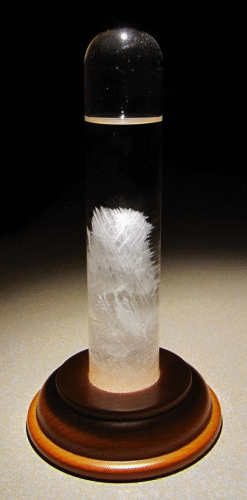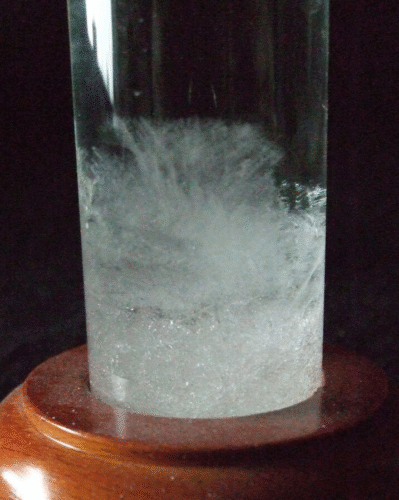Storm Jars: Victorian Weather Forecasters
Human beings have longed to predict the weather since pretty much forever. During the Victorian era, early tools to predict the weather predictions made their way into homes in the form of storm jars or storm glasses.
Not surprisingly, storm jars were especially popular among sailors and explorers, for whom the weather was often a life or death issue. Admiral Robert FitzRoy, captain of the HMS Beagle (Darwin’s famous ship), spread their use in the 1850s. He even sent them to ports and villages to help predict storms, touting their accuracy in his Weather Book of 1863. That’s why some were called ‘FitzRoy storm glasses.’
What Is a Storm Jar?


A storm jar is a sealed glass container filled with a clear liquid with crystals. These crystals form different shapes depending on the weather. If the weather was going to be nice, the liquid stayed clear. If a storm was brewing, the crystals would turn cloudy, spiky, or flaky. To people in the 1800s, it seemed like the storm jar could reveal the unpredictable weather before it happened!
The liquid mixture inside a storm jar usually consists of: distilled water, ethanol, potassium nitrate, ammonium chloride, and camphor. These ingredients were mixed together, sealed in a glass container, and then left to do their thing. Depending on the temperature and air pressure outside the jar, the chemicals would form different shapes.
Fitzroy’s original observations suggested:
Clear liquid: Clear skies
~“What is a storm glass?”
Cloudy liquid: Cloudy skies, chance of rain
Small dots in the liquid: Fog or high humidity
Cloudy with stars: Thunderstorms
Small stars on a sunny, cold day: Snow
Large flakes: Overcast on warm days, snow in winter
Crystals at the bottom: Frost
Threads near the top: Windy
The Storm Glass Barometer

Some storm jars were combined with barometers to make fancy (and decorative) weather-predicting tools. Barometers measure air pressure: lower pressure often means storms, and higher pressure means clearer skies.
These devices often featured both a traditional barometer (with mercury or a dial) and a storm glass side-by-side. These were especially popular in the Victorian era and often came in wood or brass cases, making them both useful and decorative. Wealthy families displayed them on in parlors and sitting rooms, great for stimulating interesting conversation. They also made great educational tools for young ladies learning ‘natural philosophy’—known as science today.
But Were They Accurate?
While FitzRoy pushed for the acceptance of his devices, their accuracy was questionable. Contemporary of Fitzroy, Charles Tomlinson, though declared that the device was a crude ‘thermoscope.’ He suggested, and modern science agrees, that the contents of the storm glass was sensitive to heat and nothing else.
A sad side note: FitzRoy spent his entire fortune trying to build a better weather prediction system until he lost his battle with depression and committed suicide in 1863.
References
Adams, Cecil. “Can storm glasses predict the weather?” Straight Dope. Oct 15, 2010. Accessed June 16, 2025. https://www.straightdope.com/21344056/can-storm-glasses-predict-the-weather
Adams, Cecil. “How do Storm Glasses work? Do they Work at all?” Connect Savannah. October 12, 2010. Accessed June 16, 2025. https://www.connectsavannah.com/extras/how-do-storm-glasses-work-do-they-work-at-all-2133799
“Fitzroy Storm Glass (18th Century Weather Prediction Device).” Instructables.
Accessed June 16, 2025. https://www.instructables.com/Fitzroy-Storm-Glass-18th-Century-Weather-Predictio/
Howell, Shala. “How does a storm glass work?” Part One the pondering. Caterpickles. Feb 6, 2017. Accessed June, 16, 2025. https://caterpickles.com/2017/02/06/how-does-a-storm-glass-work-part-one-the-pondering
Sciencepunk. “Storm Glass: The mysterious weather-predicting fluid crystal.” Science Blogs. September 20, 1022. Accessed June 16, 2025. https://scienceblogs.com/sciencepunk/2011/09/20/storm-glass-the-mysterious-wea
“What is a Storm Glass?”Acurite. April 4, 2022. Accessed June 16, 2025. https://www.acurite.com/blogs/weather-101/what-is-a-storm-glass-and-can-it-accurately-predict-the-weather

Comments
Storm Jars: Victorian Weather Forecasters — No Comments
HTML tags allowed in your comment: <a href="" title=""> <abbr title=""> <acronym title=""> <b> <blockquote cite=""> <cite> <code> <del datetime=""> <em> <i> <q cite=""> <s> <strike> <strong>